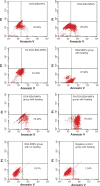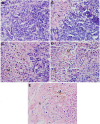Preparation of folic acid-conjugated, doxorubicin-loaded, magnetic bovine serum albumin nanospheres and their antitumor effects in vitro and in vivo
- PMID: 25228802
- PMCID: PMC4160329
- DOI: 10.2147/IJN.S67210
Preparation of folic acid-conjugated, doxorubicin-loaded, magnetic bovine serum albumin nanospheres and their antitumor effects in vitro and in vivo
Abstract
Background: This study aimed to generate targeted folic acid-conjugated, doxorubicin-loaded, magnetic iron oxide bovine serum albumin nanospheres (FA-DOX-BSA MNPs) that lower the side effects and improve the therapeutic effect of antitumor drugs when combined with hyperthermia and targeting therapy. A new nanodrug using magnetic nanospheres for heating and addition of the folate receptor with cancer cell specificity was prepared. The characteristics of these nanospheres and their antitumor effects in nasopharyngeal carcinoma were explored.
Methods: FA-DOX-BSA MNPs comprising encapsulated magnetic iron oxide nanoparticles were prepared using a desolvation cross-linking method. Activated folic acid (N-hydroxysuccinimide ester of folic acid) was conjugated to the surface of albumin nanospheres via amino groups.
Results: Folic acid was successfully expressed on the surface of the nanospheres. Electron microscopy revealed that the FA-DOX-BSA MNPs were nearly spherical and uniform in size, with an average diameter of 180 nm. The nanomaterial could deliver doxorubicin at clinically relevant doses with an entrapment efficiency of 80%. An increasing temperature test revealed that incorporation of magnetic iron oxide into nanospheres could achieve a satisfactory heat treatment temperature at a significantly lower dose when placed in a high-frequency alternating magnetic field. FA-DOX-BSA MNPs showed greater inhibition of tumors than in the absence of folic acid in vitro and in vivo. Compared with chemotherapy alone, hyperthermia combined with chemotherapy was more effective against tumor cells.
Conclusion: Folic acid-conjugated bovine serum albumin nanospheres composed of mixed doxorubicin and magnetic iron oxide cores can enable controlled and targeted delivery of anticancer drugs and may offer a promising alternative to targeted doxorubicin therapy for nasopharyngeal carcinoma.
Keywords: KB cells; bovine serum albumin; doxorubicin; folic acid.
Figures







Similar articles
-
Folic acid-modified ginsenoside Rg5-loaded bovine serum albumin nanoparticles for targeted cancer therapy in vitro and in vivo.Int J Nanomedicine. 2019 Aug 29;14:6971-6988. doi: 10.2147/IJN.S210882. eCollection 2019. Int J Nanomedicine. 2019. PMID: 31507319 Free PMC article.
-
Improved drug targeting of cancer cells by utilizing actively targetable folic acid-conjugated albumin nanospheres.Pharmacol Res. 2011 Jan;63(1):51-8. doi: 10.1016/j.phrs.2010.10.012. Epub 2010 Oct 28. Pharmacol Res. 2011. PMID: 21035550
-
Preparation and biodistribution of 188Re-labeled folate conjugated human serum albumin magnetic cisplatin nanoparticles (188Re-folate-CDDP/HSA MNPs) in vivo.Int J Nanomedicine. 2011;6:3077-85. doi: 10.2147/IJN.S24322. Epub 2011 Nov 30. Int J Nanomedicine. 2011. PMID: 22163161 Free PMC article.
-
Gefitinib loaded folate decorated bovine serum albumin conjugated carboxymethyl-beta-cyclodextrin nanoparticles enhance drug delivery and attenuate autophagy in folate receptor-positive cancer cells.J Nanobiotechnology. 2014 Oct 30;12:43. doi: 10.1186/s12951-014-0043-7. J Nanobiotechnology. 2014. PMID: 25358257 Free PMC article.
-
Antitumor Activities of Metal Oxide Nanoparticles.Nanomaterials (Basel). 2015 Jun 9;5(2):1004-1021. doi: 10.3390/nano5021004. Nanomaterials (Basel). 2015. PMID: 28347048 Free PMC article. Review.
Cited by
-
Mineral medicine: from traditional drugs to multifunctional delivery systems.Chin Med. 2022 Feb 10;17(1):21. doi: 10.1186/s13020-022-00577-9. Chin Med. 2022. PMID: 35144660 Free PMC article. Review.
-
Gliadin Nanoparticles Containing Doxorubicin Hydrochloride: Characterization and Cytotoxicity.Pharmaceutics. 2023 Jan 4;15(1):180. doi: 10.3390/pharmaceutics15010180. Pharmaceutics. 2023. PMID: 36678809 Free PMC article.
-
GEM-loaded magnetic albumin nanospheres modified with cetuximab for simultaneous targeting, magnetic resonance imaging, and double-targeted thermochemotherapy of pancreatic cancer cells.Int J Nanomedicine. 2015 Mar 30;10:2507-19. doi: 10.2147/IJN.S77642. eCollection 2015. Int J Nanomedicine. 2015. PMID: 25848268 Free PMC article.
-
An in vitro and in vivo study of gemcitabine-loaded albumin nanoparticles in a pancreatic cancer cell line.Int J Nanomedicine. 2015 Oct 30;10:6825-34. doi: 10.2147/IJN.S93835. eCollection 2015. Int J Nanomedicine. 2015. PMID: 26586944 Free PMC article.
-
Folic acid-modified ginsenoside Rg5-loaded bovine serum albumin nanoparticles for targeted cancer therapy in vitro and in vivo.Int J Nanomedicine. 2019 Aug 29;14:6971-6988. doi: 10.2147/IJN.S210882. eCollection 2019. Int J Nanomedicine. 2019. PMID: 31507319 Free PMC article.
References
-
- Glastonbury CM, Salzman KL. Pitfalls in the staging of cancer of NPC. Neuroimaging Clin N Am. 2013;23:9–25. - PubMed
-
- Han BL, Xu XY, Zhang CZ, et al. Systematic review on Epstein-Barr virus (EBV) DNA in diagnosis of NPC in Asian populations. Asian Pac J Cancer Prev. 2012;13:2577–2581. - PubMed
-
- Hanušová V, Boušová I, Skálová L. Possibilities to increase the effectiveness of DOX in cancer cells killing. Drug Metab Rev. 2011;43:540–557. - PubMed
-
- Carvalho C, Santos RX, Cardoso S, et al. DOX: the good, the bad and the ugly effect. Curr Med Chem. 2009;16:3267–3285. - PubMed
Publication types
MeSH terms
Substances
LinkOut - more resources
Full Text Sources
Other Literature Sources
Medical

